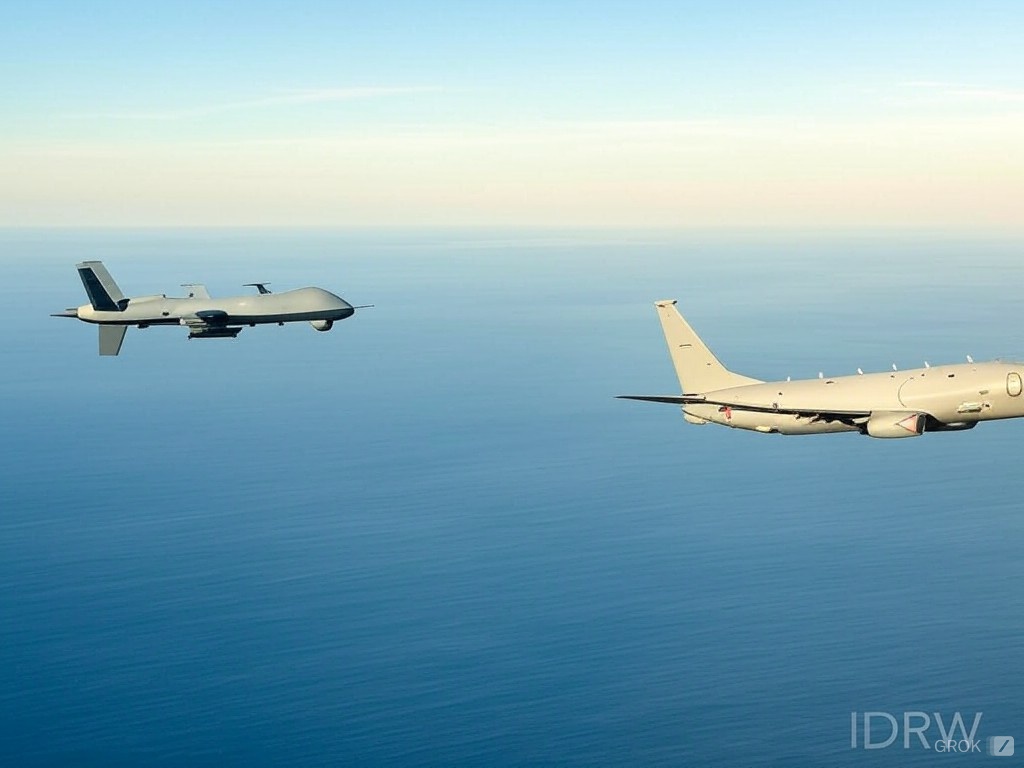SOURCE: RAUNAK KUNDE / NEWS BEAT / IDRW.ORG


The Indian Navy is planning to procure 15 MQ-9B Sea Guardian drones, a significant step that will help reduce the overall operational costs of maritime surveillance in the Indian Ocean Region (IOR). These unmanned aerial vehicles (UAVs) are expected to complement the Navy’s fleet of 12 P-8I Neptune Maritime Patrol Aircraft (MPA), which have been actively monitoring the IOR, particularly in light of increased Chinese naval presence. While the procurement of the MQ-9B comes with a hefty price tag of around $100 million per unit, Navy officials familiar with the system argue that it will lead to a substantial reduction in operating costs over time.
The P-8I aircraft, equipped with advanced sensors and anti-submarine warfare (ASW) capabilities, has been a critical asset in the Indian Navy’s surveillance operations. However, the growing presence of Chinese warships and submarines in the region has led to increased deployment of the P-8I fleet, driving up the cost of operations.
According to the United States Navy’s annual budget, the P-8A, which is nearly identical to the P-8I variant operated by India, costs approximately $175 million per unit. More significantly, the life-cycle cost per flying hour for the P-8 is estimated to be around $42,300. This high operational cost makes extensive use of these aircraft for constant patrol missions financially burdensome in the long run.
In comparison, the MQ-9B Sea Guardian UAVs, which are priced at $100 million per unit, have a life-cycle cost per flying hour of only 1/6th of that of the P-8I. If we calculate the per-hour operational cost of the MQ-9B, it comes out to around $7,050 per flying hour. This vast reduction in cost means that the Navy can achieve the same surveillance objectives at a fraction of the cost, making the MQ-9B UAVs a cost-efficient alternative to using the more expensive P-8I aircraft for routine maritime patrols.
With the MQ-9B Sea Guardians, the Indian Navy can significantly reduce its expenses while maintaining a high level of maritime domain awareness in the IOR. The UAVs will allow the Navy to conduct persistent surveillance without relying solely on the P-8I, freeing up the manned aircraft for more critical and specialized missions such as anti-submarine warfare and intelligence gathering.
The cost-effectiveness of the MQ-9B platform makes it particularly appealing as the IOR sees an increasing number of foreign naval vessels, especially from China. The UAVs can operate for longer periods without human crew fatigue, and their lower operational costs will enable the Indian Navy to maintain a consistent presence in the region, vital for tracking both surface ships and submarines.
While the P-8I remains unmatched in terms of its long-range anti-submarine warfare capabilities and multi-mission sensors, the MQ-9B Sea Guardian offers operational flexibility that is crucial in modern naval operations. Equipped with advanced radar systems, electro-optical/infrared sensors, and other payloads, the Sea Guardian can perform a wide variety of missions, from intelligence, surveillance, and reconnaissance (ISR) to search and rescue (SAR) operations.
Additionally, the MQ-9B can be deployed in situations where deploying a high-cost manned platform like the P-8I would not be necessary. For example, the MQ-9B can provide real-time imagery and sensor data during routine patrols, search for potential threats in areas of interest, and relay this data back to naval command centres, ensuring continuous situational awareness without incurring the costs associated with manned flights.
By integrating MQ-9B Sea Guardians into its fleet, the Indian Navy will be able to develop a scalable maritime strategy. The UAVs can take on routine surveillance and reconnaissance missions, while the P-8I aircraft can be reserved for higher-end, more critical operations that require advanced anti-submarine capabilities and long-range strike potential.
This division of labour will help optimize resource allocation and ensure that the Navy can maintain a constant patrol presence in the vast expanse of the Indian Ocean without stretching its operational budget. Given the expanding scope of India’s naval responsibilities, this cost-effective solution is critical to ensuring that the Indian Navy remains well-prepared to address both traditional and non-traditional threats in the IOR.
NOTE : Article cannot be reproduced without written permission of idrw.org in any form even for YouTube Videos to avoid Copy right strikes. Websites doing illegal reproductions will get DMCA and Legal Notices.